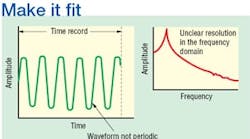Dynamic signal analyzers use Fast Fourier transforms (FFTs) to process and deliver frequency information; an FFT generally works with a group of samples of equal time duration. These samples fall within the time record, a “snapshot” of the continuous wave. But to process and analyze the data effectively, additional mathematical manipulation may be needed.
When measuring repetitive signals (like sine waves), the time record generally encompasses numerous cycles. Ideally, the time record is of a duration that grabs an exact integer number of cycles – the wave will begin and end at a coincident point. In reality, it is often difficult to get the input function to be periodic in the time record, as the ideal situation is called.
An effective FFT of such a wave relies on the appearance of continuity for all time. If the time record begins and ends at different points on the cycle, the wave appears discontinuous; tying the front of the sample to the back (emulating a lack of interruption) will result in jump discontinuities, with a cusp or a total separation in the waveform.
To mitigate the influence of discontinuities, window (or weighting) functions are imposed on the waveform, framing it within the time record so that it complies with the FFT’s interpretation of continuity; the window focuses the FFT away from the edges of the sample, where the discontinuity is observed.
The most common is called a Hanning window. It multiplies the signal amplitude by zero at the beginning and end of the time record, and the multiplier gradually peaks toward the center. This serves to give high resolution (determination of frequency) when time records are imperfectly matched to the signal. But amplitude readings deteriorate somewhat, since the Hanning function immediately slopes away from the middle of the record, leaving little room to recognize the full amplitude.
A similar method, the flat top, also begins and ends at zero amplitude, but increases to a plateau, peaking across a wider range than the Hanning window. Amplitude readings are strengthened appreciably, but resolution suffers, since the “filtering” effect of the window combined with the FFT is widened toward the edges of the time record, and subtle frequency components sometimes get drowned out as the stronger components are “smeared” across a broader band.
Questions & Answers
Q. Which window best measures transient signals, such as a decaying vibration from a structural impact?
A. Hanning and flat top windows are a poor choice in this situation and they will corrupt the trace of the transition dramatically by suppressing it near the origin; rather, a uniform or rectangular window is often used, which weighs the time record equally throughout. (Also known as “no window.”) To use a uniform window, however, the signal should zero by the end of the time record. Otherwise you can use a response (or exponential) window, which resembles an exponential curve that zeroes out.
Q. What about a discrete driving signal, like the force of a hammer in an impact test?
A. Indeed, to get frequency response, both the hammer and the structure need to be measured on separate channels, and while the hammer blow is sudden, it too can spawn stray signals beyond the time record. Therefore a force window is often used instead of “no window.” A force window resembles a rectangular pulse, and tends to preserve the initial impact signal perfectly.
Q. Does the Hanning window provide the best possible frequency resolution for non-decaying signals?
A. The resolution is very good, but the best FFT measurements come from unmodified signals that are either fully contained or periodic in the time record. Uniform windows, as mentioned, provide such unadulterated FFT data and would always be used

